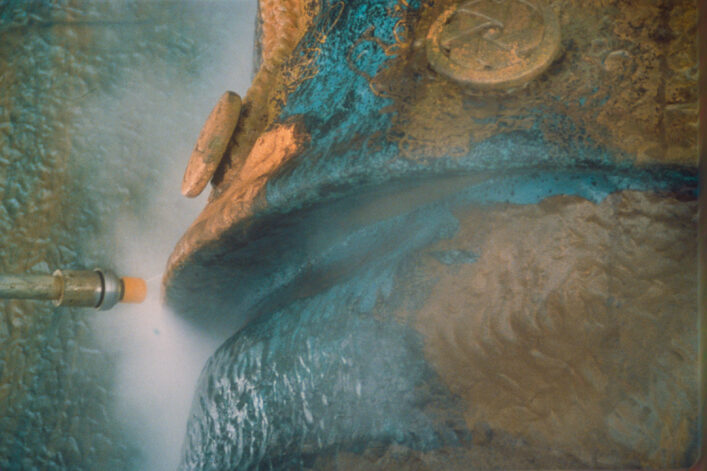Blog
Excerpted Press Release: William Penn Statue Conservation

05/31/2017 Excerpted Press Release
Moorland Studios celebrates 30 years of work on record-setting statue
PHILADELPHIA: The bronze William Penn statue that stands on top of Philadelphia’s City Hall Tower, which is the tallest building-topping statue in the world at 37 feet tall, is presently having accumulated pollution and corrosion removed from its surface. The conservation is being performed by Moorland Studios Inc., which won the first bid to conserve the statue in 1987 – for its first treatment since its construction in 1888 – and have returned every 10 years for additional treatments.
Moorland Studios is a partnership of the husband and wife team of David Cann and Constance K. Bassett based in Stockton, NJ, and Camden, SC. “This statue is an important symbol to the City and the people of Philadelphia,” Bassett said, “so it has been an honor to work with the William Penn statue for the last 30 years.” This Project is being undertaken by the City of Philadelphia’s Office of Arts, Culture and the Creative Economy. with funding provided by the City of Philadelphia, The National Endowment for the Arts and funds from the 1987 Free William Penn Campaign.

Aerial Photograph by James Bassett-Cann
The conservation process in the current project consists of using high-pressure water to remove exterior accumulation of pollutants, then stripping existing wax from its surface, and adding a new coat of chemically-enhanced wax that fills deep pores where zinc has eroded from the bronze alloy.

Ultra High Water Pressure Treatment on Coat Cuff, 1987
In the original 1987 treatment, the conservation objective was to stop corrosion and the loss of surface metal and to ensure structural integrity. Moorland removed the oxidized green and black corrosion using ultra-high-pressure water, dispensed from an industrial strength washer that delivers 28,000 PSI of water pressure. The process proved successful in removing 100 years of accumulated urban pollutants and corrosion in the deeply porous surface of the statue without removing metal or deforming the bronze in any way. Cann said, “We needed a much higher pressure washer the first time we treated the statue in 1987 because there was a century of built up degradation on the surface. Now that we treat it every ten years, we still need a high pressure to complete the challenging work, but not as much strength is needed as the initial project.”
The corrosion removal treatment made it possible to patinate (color) the statue and provided a secure bond for the protective coating. The original maquette (artist’s model) of the Penn statue was found at the Philadelphia Museum of Art, which enabled Cann and Bassett to determine the original color intended by its sculptor. The sculpture was modeled by Alexander Milne Calder, grandfather of the third-generation, modern sculptor and Philadelphia native Alexander Sandy Calder.

Perhaps the most commonly known Calder, Alexander Sandy Calder and his piece ‘Ghost’ on display at the PMA
For more on the Three Generations of Calder’s in Philadelphia.
The Conservation Laboratory at the Philadelphia Museum of Art and Moorland worked closely together to design a treatment system which has proven successful in extending expectations for the life of the coating from 2 years to 10 years. “Between the strength of the protective coating and the fact that the air in Philadelphia is considerably cleaner than it was when we started this project in 1987,” Bassett said, “the bronze in the Penn statue is much healthier than it was 30 years ago.” The coating formulation was designed to meet requirements for flexibility, ultraviolet sustainability, resistance to abrasion, and deep penetration into the porous metal casting.
Moorland Studios has previously been contracted for conservation projects including: aesthetic repair to the Statue of Liberty’s patina; fabricating and patination of bronze vitrines for the Philadelphia Museum of Art; repairs to an Auguste Rodin sculpture; and dozens of conservations for both public and private metal structures and statues.
The William Penn statue weighs 53,348 pounds and was cast in 47 sections so it could be assembled and bolted together on the top of the newly built City Hall tower dome in 1888, which was the tallest habitable building in the world at the time of its construction.
The 4th conservation of the William Penn statue began May 1st, 2017, and is scheduled to be completed by end of June, 2017.

